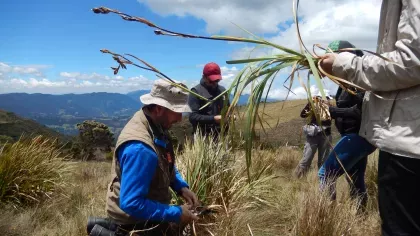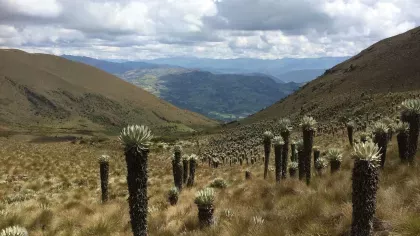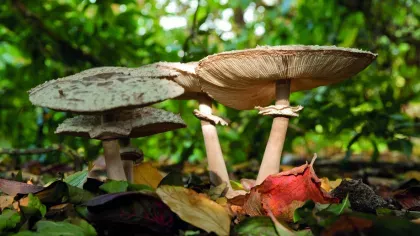Understanding the páramo grasslands of Boyacá through building knowledge of grasses
Improving baseline knowledge on the grasses of Boyacá, Colombia, their ecology and conservation, and enabling future development of grass and páramo research in Boyacá.

Background
Colombia is known to be one of the most biodiverse countries in the world. Nevertheless, the current knowledge on inventory and monitoring of biodiversity and ecosystems does not fully reflect this richness, being incomplete in certain regions. Counteracting this situation, the nation-wide ‘Colombia Bio’ programme has recently been established by the Colombian government with the main aim of making sustainable economic use of Colombia’s biodiversity resources. This programme offers a unique opportunity for Kew and partner organisations in Colombia to undertake primary research on biodiversity and ecosystem services in parts of the country as yet completely unexplored. The ambition of this exploratory research is to enable long-term plans for the conservation and sustainable use of Colombia’s natural capital to be established.
Kew Science will be involved in a significant number of research projects over the next 4-5 years (from 2017) under the umbrella of the Colombia Bio programme.
Páramo Grasslands
This particular project, to research the grass species within the páramo grasslands of Boyacá, has been designed to enable much better understanding of this unique ecosystem and the best ways to conserve it and make sustainable use of it. Kew will be acting as the delivery partner, working together with the Humboldt Institute in Colombia, the Gobernación de Boyacá, and the Universidad Pedagógica Tecnológica de Colombia (UPTC).
Grasses (Poaceae) are unique in the plant kingdom: they build and drive open canopy ecosystems, covering more than 25% of dry land. Knowledge of grass species and their modulating role in ecosystems is essential to understand the function of grass-dominated ecosystems such as the páramos.
Páramo grasslands, situated above the treeline in northwest South America and Costa Rica, are one of the world’s biodiversity hotspots, yet are unfortunately facing habitat degradation and loss from human impacts. The majority of páramo grasses found throughout the Andes can be considered endemic to this ecosystem (i.e. found nowhere else) and Colombia’s Boyacá region is no different, with 18 of the 22 Boyacá endemic grass species restricted to the páramos.
As well as high biodiversity and endemism, páramos are also unique for having evolved without significant disturbance. Unfortunately, this has created an endemic flora potentially more susceptible to the principal modern threats of livestock grazing and frequent fires, now thought to be altering the floristic composition of the páramo.
However, studies documenting human impact on these natural grasslands rich in endemic species are still lacking, confounded by poor baseline knowledge on the crucial ecosystem component, grasses. This is partly because grasses are challenging to identify and classify, and usually studied by dedicated specialists. Colombia also lacks a reference taxonomic treatment for the Poaceae, and recent checklists of Colombian Poaceae do not list any specimens held at the UPTC or FMB, the only herbaria found in Boyacá. It is likely that herbaria in Boyacá hold undescribed species and new taxonomic information. Particularly unstudied are the members of the subfamily Pooideae, which represent most páramo grasses.
In order to tackle this challenge and fill the gaps in crucial information, this project is combining ecological research on páramo disturbance with taxonomic research on grasses; special focus will be given to grasslands harbouring endemic species. The project outputs will provide the urgently needed functional understanding of the páramos, for improved land use management and conservation planning.
Kew is a historic centre of expertise on Poaceae taxonomy and identification, hosting the world’s most comprehensive grass reference herbarium. From August 2017 to April 2018, our experienced grass taxonomists will be spending time in Boyacá and with our Colombian partners in order to:
- Record grass species associations across a range of grazing and fire regimes to document the relationship between disturbance and páramo grass composition.
- Collect and identify grasses using the best international herbarium collections.
- Carry out specimen identification work at UPTC and the Humboldt Herbarium (FMB), as well as other Colombian herbaria, to produce grass checklists for the Boyacán páramos and build new taxonomic knowledge.
- This research, combined with capacity building, will improve baseline knowledge on the grasses of Boyacá, their ecology and conservation, and will enable the future development of grass and páramo research in Boyacá.
Objectives
The project aims to:
- Document the relationship between anthropogenic disturbance and Boyacá páramo grass communities, in order to develop land management strategies for ecosystem resilience
- Generate new knowledge on Boyacá páramo grass species, their identity and distribution, to underpin understanding of páramo ecosystems
Project Leader
- Boyacá páramo composition data and specimens: data on ca. 60 plots, ca. 500 collections of Poaceae fully identified and deposited at UPTC, ANDES, COL, FMB, UK and K, silica gel collections for DNA research
- Analysis of the influence of disturbance on the endemic grass ecosystems of Boyacá: paper for Journal of Ecology
- Preliminary grass checklists for the different páramos of Boyacá and anticipated taxonomic publications on new records, new species, and taxonomic revisions
- Strengthened grass expertise in Colombia through training of local students and researchers
Funders
- Royal Botanic Gardens, Kew
- UK Department for Business, Energy & Industrial Strategy (BEIS)
- UK Official Development Assistance (ODA)
- Newton Fund
- The British Council
- Colombian National Royalties’ System
- Administrative Department of Science, Technology and Innovation of Colombia (Colciencias)
Partners and collaborators
Sylvester, S.P. & Vorontsova, M.S. (2017)
Understanding the páramo grasslands of Boyacá through building knowledge of grasses (Poster)
IX Congreso Colombiano de Botanica, 30 July–4 Aug 2017, Tunja, Colombia
#KewColombiaBioBoyaca
#KewColombiaBio


